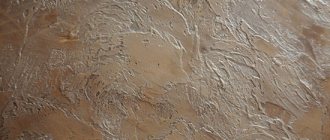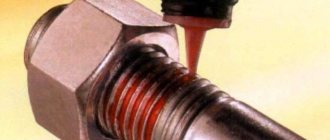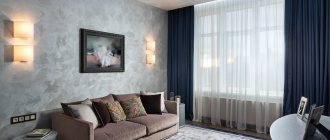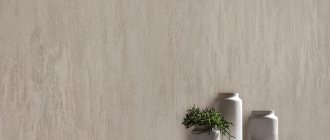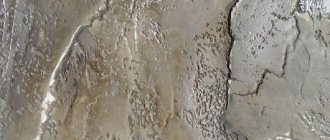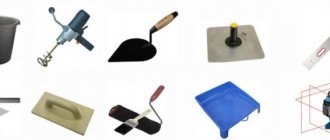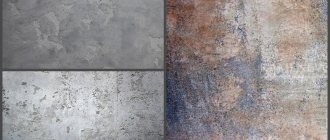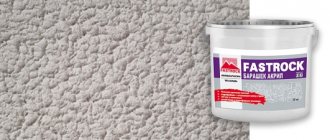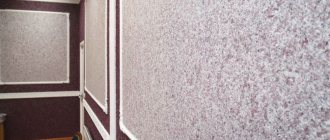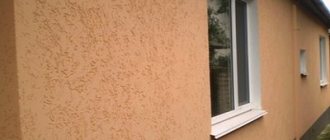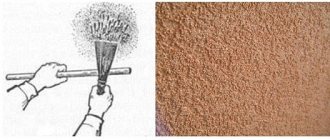Mineral plaster has been used since ancient Greece. Even then, people knew how to decorate their homes with a solution of clay, limestone and sand. The composition of decorative mineral plaster may include marble, clay, quartz sand.
The binding components are cement, gypsum, and limestone. Compositions with gypsum are most often used for interior decoration, cement and limestone - for exterior work, because it is these substances that give mineral facade plaster its resistance and durability.
Features and characteristics
Decorative plaster “orange peel” is a plastic mixture containing additives in the form of crushed mica and small pebbles. It is used for cladding walls and sometimes ceilings.
You can often see such decoration in public buildings, corridors or halls. Plaster is used in places where it may be subject to increased operational load. In its original form, the mixture is white. After application and drying, the surface can be painted using dispersion paints. You can apply a colorant, but not more than 2% in relation to the total mass.
The basis may be:
- brick;
- gypsum and cement plaster;
- plywood;
- Chipboard/fibreboard;
- aerated concrete;
- foam concrete.
The structural mixture is easily applied to the surface. The main thing is that it is a little rough.
Advantages of the material:
- strength;
- weather resistance;
- vapor permeability;
- can be used for external and internal work;
- resistant material to abrasion and damage;
- odorless, easy to clean.
The decorative coating “orange peel” is stored in a room where the temperature is maintained at +5–30 0C. It is not advisable to keep the mixture in the cold. Protect from freezing, exposure to ultraviolet rays, and do not store near heating devices. Shelf life – 18 months.
Although some boxes may be marked “Frost-resistant”. It can be stored at a temperature of -30 0C. At the same time, the product will not lose its consumer properties. If the composition was stored in a cool place, it should be defrosted only at room temperature without additional heating.
Important
If the mixture has expired or has been spoiled, it is prohibited to dispose of it in open water bodies or sewers. The dried decorative mass along with the packaging must be disposed of in a trash can, like regular household waste.
Consumption
Decorative building mixture is consumed in different ways. The consumption depends on the composition itself, the quality of surface preparation, application technique, manufacturer, brand of product. Average material consumption is 1.8-2 kg/m². One package may be enough to treat a surface measuring 6.5–7 m².
Please note that before applying decorative plaster, the surface must be carefully treated. It should be dry, strong and clean, without deep irregularities. If there is an old, weak coating left, it must be removed.
If the base is able to quickly absorb compounds, it needs to be prepared, for example, by applying a couple of layers of universal primer of any brand. It is recommended to dry the new plaster base for 4-6 weeks before applying a decorative primer.
Drying time
Decorative “orange peel” plaster dries in about a day. The plaster layer is completely ready for use or painting after 3 days. In this case, the room should have a relative humidity of up to 65%, and the air temperature should be within +20–22 ºС. Complete drying of several layers of plaster under normal conditions occurs in 2–3 days.
External decorative plaster. Features of mineral plaster for facades
The composition of mineral plaster includes slaked lime, Portland cement, stone chips, colored clay, additional elements that increase the performance characteristics of the finished surface and components responsible for the texture of the finished facade. To increase resistance to fungus and mold, the mixture may contain additional fillers.
Cement plaster for facades forms a durable, non-flammable coating with a high level of thermal insulation properties.
The mixture is available in ready-made packages in the form of a powder, which must be diluted with a certain amount of water to obtain the finished solution. It can be applied to any type of surface. Before facing the walls, it is necessary to install a mesh under the facade plaster, which will level the surface, create additional adhesion of the plaster to the base and reduce the risk of cracks.
Cement plaster for exterior use creates a durable “breathable” decorative coating that does not smolder, does not burn, and does not emit toxic substances when heated. The suitability of the composition for work is no more than 90 minutes. After complete drying, a durable non-flammable coating with sound and heat insulation properties is formed on the wall surface. The decorative effect of the finishing material is provided by colored additives and granules.
On a note! Due to its low vibration resistance, mineral plaster should not be used for buildings located near railways and in areas with increased seismic activity.
Mineral plaster can withstand temperature fluctuations from -30 to +45ºС. without losing its performance properties. The service life of such coating is at least 15 years.
To give a more aesthetic appearance to a cement plaster coating, you can use façade paint for exterior use.
The color range of cement plaster is very limited, which reduces its decorative value. The finished surface of cement plaster can be painted in any color, thereby creating a more aesthetic appearance of the building.
Today, Knauf mineral facade plasters from the Diamant line, which have increased moisture-repellent properties and resistance to aggressive weather conditions, are very popular. Using a mixture of Diamant-240, you can obtain a textured “bark beetle” surface, and Diamant-260 forms a rough veneer, which is called a “fur coat.” The price of a 25 kg package is about 900 rubles.
Another equally popular option is Bolars mineral facade plaster, which can be purchased at a price of 700 rubles. Having a self-leveling structure, thanks to the modifying additives included in its composition, it creates a perfectly flat and smooth surface.
The moisture-repellent properties of plaster for exterior use help to avoid dampness and mold development in the house.
Required Tools
For application, the most common painting tools are usually used:
- spatula of different sizes;
- trowel;
- masking tape;
- soft brush or metal trowel;
- mixing container;
- roller;
- protective gloves.
It is advisable that the tools are made of stainless steel.
How to apply the mixture: application technology
The interior design of an apartment determines our mood. The surface of the walls looks more impressive with an interesting design - a beautiful decorative “orange peel” coating.
Everyone can apply decorative plaster themselves. To make it look attractive and last for many years, it is important to follow the coating technology.
How to apply the structural mixture:
- After opening the package, stir the contents.
- The composition is applied to the surface with a trowel made of stainless steel.
- After applying the mixture, it must be leveled over the surface with a layer of 1.5-2 mm.
- After 5–10 minutes, walk with a trowel over the applied layer 1 mm thick and remove the excess.
- Use plastic grout to form the required structure.
If the decorative plaster is already painted in a rich tone, then it will take a little more time to begin to form the structure.
Important
It is important not to forget to treat the surface with a primer before work. The wall should not be smooth, otherwise the mixture will not adhere well.
The composition has good plasticity, so layers of mortar are applied thicker to hide minor irregularities or cracks in the walls. Then, using a spatula, spread the plaster evenly over the entire surface. You need to work quickly as the mixture dries out quickly. It usually takes 10–15 minutes to structure the surface, after which it becomes more difficult.
At the very beginning, it is important to walk along the border of the surface with masking tape or tape. When the solution becomes solid, it can be removed. The room temperature should not be lower than +10–15 0С for three days.
The composition of decorative plaster includes natural components of natural origin. To avoid color differences, it is advisable to use a plastering mixture with the same packaging lot number plate. After work, all tools are cleaned and washed.
For the finishing coat, you should select your favorite shade in advance. Use a plastic spatula for mashing. From time to time, moisten it in water so that it glides over the surface better and the solution does not stick. Light movements - strictly circular.
All about decorative plaster. How to apply plaster on walls correctly
Application of various types of decorative plaster accordingly requires careful surface preparation. It will first be necessary to level out any existing defects. As a rule, gypsum, cement-sand and lime mortars are suitable for these purposes.
Next comes 1-2 layers of primer. The product is applied only after the surface has completely dried. Subsequent activities will depend on the working composition, and besides, there are quite a lot of ways to apply “decorative” materials.
Thin single layer coatings
Imitation with woven materials looks elegant. Such coatings, due to the application of minimal layers, require high-quality surface preparation. It is recommended to work with a brush. The desired effect can be achieved using vertical, horizontal or circular movements.
The composition of the product is dominated by glass, quartz sand and metallized powder.
Fur coat
Fur coat is both an economical finishing material and easy to work with. It gives a rough texture. It is painted with pigment added to the solution, or tinted with a roller at the final stage.
The technology for applying this type of decorative plaster involves preparing a creamy mortar and throwing it on the wall. To level the layer, use special spatulas and steel trowels.
To add texture, use a brush or a piece of artificial fur. It is important to carry out manipulations on a fresh surface. For protection, the wall is treated with acrylic varnish or wax.
Venetian plaster
With the help of Venetian plaster it is easy to imitate both polished and untreated stone. Beautifully modeled:
- lapis lazuli;
- granite;
- malachite;
- sandstone;
- marble;
- travertine.
Polished imitation
This technology is often used to recreate granite and marble stones. The task does not require special skills; the main thing is to try to replicate the natural pattern with inclusions and veins.
If you want to bring luxury and nobility to your home, follow the following recommendations on how to apply decorative plaster:
- Preparing the walls. They must be perfectly smooth, dry, and primed.
- We dilute the mixture according to the instructions.
- Tinting. Add the desired pigment to the prepared solution. To imitate, for example, marble, you will need four colors. Shades of gray, white and black are suitable. Each of them should be diluted in separate containers.
- Application. We use two spatulas and transfer the composition from the small one to the large one. The colors are used all at once, light shades should predominate, the main thing is not to mix them. There are other options for applying this type of decorative plaster; they are simpler, but will take more time. We take the primary colors and set the diagonals, then use the rest. In some areas, small inclusions of more saturated shades are made.
- Adjustment. At this stage, the working surface is leveled with a damp trowel and rubbed down.
- Polishing. The dried “work” is treated with primer and varnish. To give the wall the gloss of polished stone, wax is applied to it and polished, without the use of varnish.
Photos of the interior
In the following photo you can see what this coating looks like in the interior of the room:
Manufacturers
Kratzputz
Dufa plaster is used for finishing surfaces. Its real name is Kratzputz. Most often, people refer to it as “orange peel”, however, there is another unsightly name – “cellulite”.
Plaster is used both for interior work (wall finishing) and for external plastering, for example, building facades. The orange peel effect is recreated using the technique of applying a plastic mixture. The Dufa-Kratzputz brand also plays an important role here. Its fine-grained composition is easy to apply and spread over the surface.
Decorassa
Plaster from the Russian manufacturer Decorassa has been on the construction market since 2011. The brand directs its efforts to attract customers.
Attention
It has gained great popularity due to its good quality and affordable prices.
Plastic mixture for decorating surfaces Decorassa is a good analogue of foreign products. The composition has excellent performance properties and a wide range. You can choose any coating from the manufacturer's catalog.
Structural plaster based on acrylic "orange peel" "Olympus" is used as a decorative and protective finish for any surface: both a facade, a vertical architectural element located outside, and rooms, apartment walls. Ideal for a modern warm facade.
Textured mixture "Latek-L306"
With the textured mixture “Latek-L306” it is easy to recreate the “orange peel” effect on the surface. High quality mixture. Package weight - up to 15 kg. Used for finishing facades and walls of premises. The composition is made of safe materials that withstand operation regardless of climatic conditions. This is a quality product.
Brand Optimist Elit
The Optimist Elit trademark has been operating on the construction market for more than one year. The large catalog contains a wide range of decorative plasters, including “orange peel” plasters. The “Silk Road” deserves special mention.
This type of plaster is expensive, but the result is worth it. The composition is unusual, durable, and environmentally friendly of the finished coating. Optimist Elit decorative plaster on the walls creates the necessary texture.
Reviews
The article was created to assist in choosing decorative plaster with an “orange peel” effect. The reader himself makes the decision: whether he needs this type of decoration, whether it suits the design of an apartment or other room.
Advice
When choosing construction products, reviews from customers who have already tried working with this material play an important role.
Especially those who have been using decorative plaster in their interiors for several years. They will be able to tell you all the nuances or warn against a bad manufacturer or low-quality brand of product.
Here are some reviews from real people who have used this type of cladding.
- Vasily, 52 years old: “I needed to make repairs in the bathroom. I decided to apply textured plaster. To save money, I did all the work myself. I looked through a lot of information on the Internet, watched videos with master classes. I chose an interesting option for myself - “orange peel” plaster. My walls are smooth and primed, so the plastic mixture fit perfectly. I was pleased with the result, I recommend it!”
- Peter and Svetlana, 30 years old: “They did decorative plaster in the kitchen. Now this is my favorite room in the apartment. The walls stand out interestingly against the background of furniture and household appliances. We advise you to decorate the wall near the stove with tiles, otherwise it will be difficult to remove the grease. We have already corrected our mistakes, but don’t make them.”
- Natalya, 47 years old: “I decided to apply decorative plaster myself. I got tired very quickly, since I need to work with the composition without relaxing much. As soon as I applied the composition to the wall, I made the texture halfway, and the rest began to dry out. I'm just exhausted. I had to do it in a small area and not rush the work. Plus – it looks beautiful, minus – the mixture dries quickly on the wall.”
- Ivan, 45 years old: “Orange Peel is easy to use. The mixture is flexible. It is convenient to apply and level with a spatula, and to create a structural texture with a roller. It's simple. I didn’t have to invite workers, I managed everything on my own.”
Bark beetle plaster “Bark beetle” plaster: characteristics and application features
A modern type of plaster called “Bark Beetle” is one of the most popular finishing materials. The original coating is famous for its aesthetic and protective properties. Simplicity and ease of use make it a universal material in all respects.
Features of the composition
The main components of plaster are granules and powder. The size of the grains varies from 1 to 5 mm. It affects the amount of material required. The larger the grains, the more mixture required. It also affects the expressiveness of the drawing.
The mixture may consist of plaster, cement or acrylic. Marble or mineral sand grains are used as granules. The disadvantage of a gypsum or cement mixture is that, unlike an acrylic composition, they must be diluted before application. It is important to follow the cooking technology and proportions here.
The advantages of plaster include the presence of a huge selection of compositions. Each manufacturer cares about improving the quality and increasing the versatility of its products. Therefore, despite the presence of the main components of the mixture, additional substances are added. Depending on the desired result, you can always select the most optimal characteristics.
Do not neglect the advice of professionals. A competent consultation will allow you to understand the variety of components and their combination with the initial data.
Types and characteristics
The name of the plaster "Bark beetle" comes from the name of the insect - the bark beetle, which leaves peculiar indentations on the tree.
The unique appearance of the outer surface is formed by small or large depressions that imitate the footprint of a beetle. The pattern is formed by marble, mineral chips or titanium dioxide. The effect of a tree eaten by a bark beetle is created.
It should be noted that the technical characteristics of decorative plaster compositions may differ depending on the quality and type of constituent components.
The compositions differ in purpose:
- for finishing walls indoors;
- for exterior decoration of houses;
- universal compositions.
Difference by type of main component:
- Mineral mixtures based on cement or gypsum have a service life of at least 7 years. Due to their resistance to low temperatures and high humidity, they are used for finishing the external surfaces of houses.
- Acrylic-based polymer mixtures are very plastic. Thanks to this property, the risk of cracking is eliminated. Under favorable conditions, the composition can retain its qualities for 20 years. Acrylic mixtures are often used for finishing interior walls and ceilings.
- There are also mixtures based on silicone resin, which have plasticity and moisture impermeability. Under favorable conditions, their service life is 10-15 years.
Differences in degree of readiness for use:
- ready-made solutions;
- dry mixtures requiring dilution.
The advantages of textured bark beetle plaster also include:
- Durability. The plaster can withstand mechanical stress and vibration. Has a long service life.
- Easy to care for. Dust and dirt can be easily cleaned with water or any detergent.
- Resistance to temperature changes. The material easily tolerates temperatures of minus 50 degrees.
- The absence of harmful substances in the composition prevents the appearance of toxic particles in the air. This allows the material to be used inside living quarters and children's rooms.
- Fire resistance. The material is not flammable, which makes it possible to use it in the kitchen, next to the fireplace.
- Easy to apply. Following the correct technology allows you to make repairs indoors with your own hands.
- Original texture. The unusual pattern goes harmoniously with almost any type of interior design.
- Relatively low cost. The presence of a huge number of manufacturers allows you to choose the most optimal option for any budget.
- Lightness of composition. The material does not create additional load on the supporting structures, which significantly reduces the risk of damage or wear.
Knowing the characteristics of the compositions allows you to easily navigate the variety of offers on the market.
Where to order and buy?
Decorative “orange peel” plaster is quite easy to find in construction stores. There are many online stores on the Internet where you can order goods by mail. There you can also purchase the necessary painting tools that will be needed when applying the mixture.
Sellers will be happy to advise on any issue, offer the best options, and take into account the buyer’s wishes.
Plaster for decoration with an “orange peel” look will be a fresh solution for any interior. With it, the surface will be transformed beyond recognition, so the situation will be transformed quickly and without unnecessary costs.
Textured plaster. Tools for working with relief plaster
Many of the tools shown are highly specialized and designed specifically for working with embossed decorative plaster
When decorating a wall with decorative plaster and using it to form a relief pattern, use the following tools:
- To mix the plaster mortar, you will need a drill and a mixer attachment. With their help, you can easily and quickly enough, without much effort, make the mixture plastic and homogeneous.
A universal tool is a spatula, and in our case we also cannot do without it.
- Spatulas of various sizes - these tools can be called the main ones when working with any plaster, since you cannot do without them when applying any of the finishing layers.
- A trowel or trowel is also often used to coat surfaces with plaster solutions.
- A special glove that is used both for creating relief and for coloring it.
A wide variety of household items can be used
- A brush with hard or soft bristles, plastic film, rubber gloves, a sponge or a plastic mesh for washing dishes.
- Using a roller and rubber attachments can be called the most popular way to make a wall in relief. The variety of these devices allows you to choose one of the many textured patterns offered by the manufacturer.
In addition, using this technique, the work goes faster, and the print on the wall turns out neat and aesthetic, however, such reliefs cannot be called exclusive. The attachments on the rollers can have patterns of plant patterns, waves, various curls, geometric shapes and others.
A variety of rollers to give relief to a plastered wall
Reliefs that imitate the texture of leather or tree bark, as well as other natural materials, look especially impressive.
Very original reliefs imitating tree bark and crocodile skin
Nozzles can create a textured pattern located vertically or horizontally, chaotically or perfectly correctly - this factor will depend on the preference of the owner of the home being decorated.
Rollers for giving plaster a geometrically correct linear relief
Textured plaster expands the possibilities of transforming walls, and the presence of a variety of tools opens up scope for creating numerous designs. It should be noted that craftsmen who professionally engage in this art, when making reliefs, often use completely unexpected tools and household items, for example, wood chisels, manicure spatulas, or even ordinary teaspoons.
